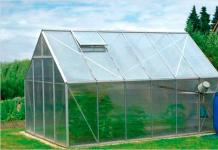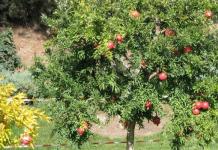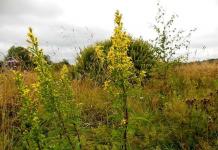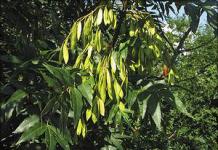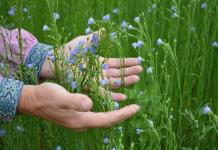The Valley of Flowers National Park is a national park on the territory of the World Biosphere Reserve, which is located high in the mountains in the Indian state of Uttarakhand (formerly Uttaranchal), about 600 km northwest of Delhi.
The park is known for its exceptional picturesqueness, while alpine meadows with their endemic flora are of particular value. Adjoining the Valley of Flowers is the chain of mountains of the neighboring Nanda Devi National Reserve, the highest peak of which rises to 7816 meters. Both parks have been famous among climbers and botanists for hundreds of years, and the Hindus revere these mountains as sacred.
Almost everything around in the Valley of Flowers is a rarity. In less than 2,500 hectares, there are over 600 species of subalpine, alpine and alpine plants, such as the Himalayan maple and blue poppy, which, along with three other species, are found nowhere else. Another 31 species are recognized as endangered, and 45 others are medicinal plants used daily by local residents. The last few are used for religious sacrifices to the deity Nanda Devi and other deities.
Himalayan blue poppy:
Morina longifolia:
Type of gravel:
The fauna here is also extremely specific. There are 114 species of birds in the valley. Here, in the rhododendron groves, the broad-tailed and scaly-bellied woodpeckers, the blue-faced bearded, mountain pheasant feel great. Also, 13 rare and endangered species of animals live in the valley, such as the black bear, snow leopard, yellow marten, blue sheep, Himalayan musk deer.
Musk deer (musky deer-like animal, males have fangs):
The best time to visit the Valley of Flowers is from June to September. They usually get here from the city of Joshimath to the city of Govindghat by car (travel time is an hour), then they climb along the path along the narrow and beautiful gorge to the Ghangariya campsite (14 km), from where hiking routes to the Valley of Flowers and to Hemkund Sahib lake.
Govindghat:
It is strictly forbidden to set up a camp in the valley itself, there are no conditions for people to live in the park. Tourists are accompanied by a local guide who lays the route away from places where you can find valuable plants and rare animals. You can only move around the park on foot, even the entry of beasts of burden is prohibited. All this is done in order not to disturb the fragile ecological balance in the valley.
Above the Valley of Flowers at an altitude of 4329 meters is the crystal clear lake Hemkund Sahib. In the sacred book of the Sikhs, the Great Sahib Sikh, Guru Gobind Singh tells how in his past life he meditated on the shore of a lake surrounded by seven peaks crowned with snow turbans. Later this lake was identified as Hemkund. During the search for the exact place of meditation of Guru Sahib, an old man who appeared on the way pointed to a flat piece of rock next to the lake and told that it was on it that the guru meditated. After that, he disappeared, as if dissolved. In 1933, exactly at this place, indicated by the mysterious old man, the foundation stone for the construction of the future gurudwara (Sikh temple) was laid. Its construction was completed in 1936. Now this place has become one of the centers of pilgrimage.
Gurudwara
Gurudwara, inside view:
Lake Hemkund Sahib has other names: Lokpal, Lakshman Kund. According to the locals, Lakshman, the younger brother of the god Rama, also meditated on the shores of this lake. A temple dedicated to Lakshman was built a few meters from the gurudwara.
Despite the fact that the water in the lake is very cold, pilgrims still bathe in the holy lake.
Lake Hemkund Sahib:
In 1982, the Valley of Flowers was declared a national park, and in 2005 it was included in the World Heritage List as part of the Nanda Devi and Valley of Flowers National Parks.
Absolutely every flower is the embodiment of the ideal beauty created by nature. A special harmony is hidden in the valleys, covered with carpets of flowers. These are picturesque masterpieces that heal the soul.
There are many fabulous places on our planet, among which blooming valleys have gained special attention. Here are five beautiful places that delight us with fabulous flowering at different times of the year:
1. California Poppy Valley (California, USA)
The Antelope Valley is located in the west of the desert called Mojave. Every year, the territory is strewn with yellow-orange poppies in huge numbers. Only here in the period from April to May you can see these flowers in these parts. The valley itself is gray and dull, but when a carpet of flowers appears, the landscape transforms beyond recognition.
2. Valley of the steppe tulip (Kalmykia, Russia)

Tulip festivals are held annually around the world. The most colorful in Istanbul and the Netherlands. But such a colorful action exists in the wild. The proof is the tulip steppes of Kalmykia, which are located in the Manych valley. In the spring, an annual festival is held here, the purpose of which is to protect the flowers from extinction as a result of reckless human activities.
If you are planning a vacation in the spring, you can go to the Tulip Valley. And in June it's beautiful in Sochi. On https://gkkiparis.ru/otdyh-v-iyune/ you will find out which complex to stay in Adler, what entertainment is available, and also see prices and reviews.
3. Lupine Valley (South Island, New Zealand)

Landscapes on Lake Tekapo would look ordinary if it were not for the delightful arrows of lupins that are scattered throughout the entire valley of the island. Beauty lasts from mid-November to mid-December. This is quite enough to appreciate the magic of flowers, to fall in love with these exotic plants against the backdrop of the majesty of the mountains and the lake.
4. Rose Valley (Kazanlak, Bulgaria)

The beauty and fragrance of roses is undeniable. Enough to enjoy the wonderful smell really in the fabulous rose valley in Bulgaria. In mid-May, hundreds of thousands of roses bloom at the same time and delight tourists until mid-June. The flowers are harvested to produce rose oil, which is used in perfumery and cooking.
5. Valley of Flowers (Western Himalayas, India)

The national park in India is perhaps the most famous. Its large territory is covered almost all year round with different types of plants (more than 500). The most colorful are orchids, anemones, daisies, poppies and primroses.
Each flower is the embodiment of ideal beauty, which only nature can create. Harmony and incredible power are hidden in it, capable of creating a masterpiece of art with its magic, and turning boring sandy landscapes into picturesque paintings that heal the soul.
Every year on our planet at one time or another, people can enjoy an incredible fairy tale - the flowering of plants. Some plantations are fragrant thanks to man, while others are the result of nature, but in any case, flowering plants amaze with their beauty. You can admire their fabulous flowering both in special gardens and parks, and in wild valleys.
1. Wild Calla Valley (Big Sur, California)

The rich coastal vegetation of the Big Sur region has become known throughout the world thanks to the marvelous white flower that blooms annually in March (the period of active flowering) on the Pacific coast. Callas are graceful plants that, against the backdrop of mountains and a Pacific sunset, give the impression of a fairy tale come to life. A defenseless and delicate flower grows surrounded by natural protection - poison ivy, nettles and deep ravines, which helps it to defend itself from the barbaric "connoisseurs" of beauty, ruthlessly destroying it for their whims.
2. Valley of daffodils (Khust, Ukraine)

The beauty of the Carpathian Mountains is able to surprise with its incredible riot of narrow-leaved daffodils in the Khust-Solotvyno Valley, which annually pleases tourists who come here in May. The unique valley of daffodils has practically no analogues, only plantings similar to it exist in the Alps, the Balkans and the mountainous regions of Romania. But their main difference is that flowers grow directly in the mountains (and not in the valleys) and occupy much smaller areas. Like other natural wonders of the planet, the valley of daffodils is slowly disappearing from the face of the Earth, but scientists are confident that they can find a way to prevent this process.
3. California Poppy Valley (California, USA)

The Antelope Valley is located in the western part of the Mojave Desert. Every year, its territory is covered with wonderful yellow-orange poppies, which can only be seen in the local parts of the national park from April to May. The flowers of plants are unique in their color, the area of their natural growth ends in California and nearby states. Almost all the time the valley looks gray and dull, but in the spring a bright carpet of delicate poppies brings rich colors of yellow and orange tones into the fresh landscapes of nature, which radically changes the whole picture.
4. Valley of the steppe tulip (Kalmykia, Russia)

Every year, fantastic tulip festivals are held around the world, the most colorful of which are festivals in Istanbul and Lisse (Keukenhof Park, the Netherlands). But even in the natural (wild) environment, as it turns out, such colorful actions are possible. An example of this is the tulip steppes of Kalmykia, located in the Manych valley. Every spring, a special conservation festival is held here to protect flowering plants from extinction, which leads to reckless human activity.
5. Lupine Valley (South Island, New Zealand)
The picturesque landscapes of Lake Tekapo would probably look rather ordinary and boring if it were not for the fabulous multi-colored arrows of lupins scattered throughout the valley of the island. Unfortunately, all this fragrance lasts no more than a month (from mid-November to mid-December), but even this period is enough to fall in love with incredibly beautiful paintings created by nature itself. Tall exotic plants, painted in bright rich colors, against the backdrop of sky blueness and the majesty of the mountains, become masterpieces even in the hands of an inexperienced photographer.
6. Rose Valley (Kazanlak, Bulgaria)

The rose makes one admire the beauty of its delicate flowers. The flowers collected in a bouquet look incredibly beautiful and filled with life. Their aroma intoxicates and excites, you want to inhale it again and again. You can enjoy the wonderful smell of the royal flower in the fabulous valley of roses near the town of Kazanlak. Hundreds of thousands of roses open their colorful buds in mid-May and continue to bloom until mid-June. During this period, the "blooming harvest" is harvested, which is further processed in order to obtain rose oil - a unique raw material used in a wide variety of industries, from perfumery to cooking.
7. Valley of Flowers (Western Himalayas, India)

A special place in the list of incredibly beautiful annual flowering valleys is occupied by the Indian National Park "Valley of Flowers". Its large-scale territory is covered almost all year round by various types of plants (more than 500), the most colorful of which are orchids, poppies, anemones, daisies and primroses. There have long been legends about the beauty of these places, which say that fairy fairies live in the Valley of Flowers, capable of fulfilling any desire. It is difficult to believe in the truth of legends, having never visited these parts, in incredibly beautiful places where the owners are the rarest species of animals.
Valley of Flowers, or Valley of Flowers - this is the name of India's largest national park. Once in this beautiful place, even the most inveterate skeptic will not be able to remain indifferent. Majestic mountains covered with glaciers at the top, and birch and rhododendron forests below, small picturesque waterfalls, a light mist of fog, and endless flower carpets - all this allows us to call the local landscapes one of the most interesting places on the planet .



The Valley of Flowers is located high in the Himalayas (from 3 to almost 7 thousand meters above sea level), where the famous water artery of India, the Ganges River, originates. The national park is located between two high mountain ranges (Zaskar and Greater Himalayas) and covers an area of almost 9 thousand hectares. The length of the reserve is about 12 kilometers, and the width is almost 10. In the 1980s, this place was declared a national park of India, and 20 years later it became part of the UNESCO World Heritage List.



What flowers are not here! Orchids, marigolds, poppies, daisies, daisies, primroses, anemones and many others. In total, more than 500 species of flowering plants grow in the Valley of Flowers, including dozens of unique ones, such as the blue poppy. Many of the local flowers are considered medicinal and have been consumed by the inhabitants of the surrounding area for centuries.



Beyond the original beauty Valley of Flowers It is also known as a place where rare species of animals live: blue sheep, Himalayan bear, snow leopard (irbis) and yellow marten. More than a hundred birds live in the Valley of Flowers, such as pheasants, snow doves, Himalayan snowcocks and golden eagles, hawks.





Since ancient times, local peoples have known about the existence of a wonderful flower valley high in the mountains. Since then, myths have come down to us that tell about the life of wonderful fairies in these most beautiful places. And who else could folk fantasy settle in such an amazing place, except for good fairy-tale characters?


Only a few of those who purchase tours to India manage to visit the Valley of Flowers. In order to get to the reserve from Delhi, you need to spend almost a day. Difficult and climbing the mountains. For those who still decide on a difficult journey, you need to know that it is best to admire the valley in July and August, when most plants reach their peak of flowering. At the same time, the temperature high in the mountains approaches the annual maximum - 17°C. The nearest town to the Valley of Flowers is called Joshimath. It is located 17 kilometers.
A multi-colored sea of flowers swaying in the wind, high mountains, bright sun - flower valleys are truly impressive. Huge placers of fragrant plants are found in almost every country: Ukraine, Bulgaria, India, France, Holland. Many tourists want to admire such beauty and feel like in a fairy tale. In this article, we will look at the most beautiful and stunning flower valleys.
Bulgaria. rose valley
In the intermountain region near the Bulgarian city of Kazanlak, since the 18th century, a fragrant Damascus rose has been grown. The rose brought from Syria later became the symbol of Bulgaria. Thanks to its chic aroma, the flower is used as a raw material for essential oil, which is considered the best in the world. Roses bloom here from May to July, and a festival dedicated to the rose is held in mid-May. It begins with the ritual gathering of petals and ends with the selection of a new Rose Queen.

USA, Arizona. valley of poppies
Every year from February to June, the gray Mojave Desert comes alive with vibrant oranges and reds. In the valley of poppies, or the valley of antelopes, in the middle of the last century, local residents brought their herds, but now this is prohibited. Poppies are not watered and do not stimulate their growth, so as not to disturb the natural appearance of the valley. There are trails for tourists, you can’t go off them either. The paths are arranged so that the valley can be viewed from all angles, and on the benches you can relax and admire the wonderful flora and fauna of this area.

USA, California. Calla Valley
A unique spectacle - the bloom of wild callas against the backdrop of the Pacific Ocean - appears here in March. This valley is considered a dangerous place, because it is surrounded by poison ivy, stinging nettles and deep ravines. For tourists, paths have also been laid here, from which it is forbidden to go for safety reasons. Paths lead from the beach, where the high waves of the ocean break on the shore, to a dense forest of huge sequoias.
It is believed that calla lilies predict the weather better than any weather forecaster: before rain, water droplets appear on the tips of the leaves.

France. Lavender fields
A large number of the fields of Provence in France are covered with a carpet of fragrant lavender. The city of Valensole is literally immersed in these delicate purple flowers: even the houses of local residents are decorated with lavender. Here you can also buy natural cosmetics containing lavender essential oil, soap, honey, bags with dried flowers.
Lavender blooms from June to August, but already in July they begin to mow it. When visiting lavender fields, beware of wasps: they are attracted by the bright scent of flowers. The best way to get around Provence is by car to see as many fields as possible, or by bike.
During the lavender harvest period, festivals dedicated to this flower are held. Such a holiday can be visited in Valensole: it is usually the third Sunday of July.

India. Valley of Flowers
The largest national park in India is full of the brightest colors and shimmers with waterfalls. It is located in the Himalayas and is surrounded on all sides by high mountains covered with glaciers.
Locals believe that this place is magical and inhabited by fairies. Multi-colored flowers (primroses, poppies, lilies, rhododendrons, medicinal chamomile and calendula), amazing animals (snow leopards, foxes, bears) - what you will not see here! It is worth taking a few days to explore the valley in order to have time to see as much as possible. It would not be superfluous to take an umbrella: it often rains here.

In addition to the valleys listed in this article, there are many others in the world. For example, an endless sea of daffodils in the Ukrainian Transcarpathia or a valley of bright tulips in the Netherlands. Visiting such beautiful places will give vivid memories of wonderful views and fragrant aromas.


